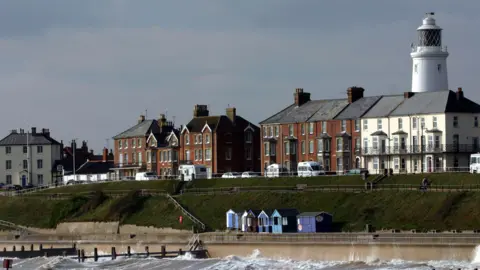The English coastal town and the Tour de France
 Getty Images
Getty ImagesThe Tour de France's links with England may not be immediately obvious, but one English coastal town played a small role in its creation.
Sports journalist Victor Breyer, who was born in Southwold, Suffolk, was embroiled in a controversy that indirectly led to the founding of the race in 1903.
His origins were uncovered by present-day journalist, broadcaster and author Ned Boulting, who wrote about the race's birth in his most recent book.
Boulting said Suffolk could "bask in a very small amount of reflected pride" in Southwold's role in the birth of the Tour de France.
In his book 1923: The Mystery of Lot 212 and a Tour de France Obsession, Boulting explains that Breyer's father was Frenchman Christian Breyer.
While on a visit to London, he met Emma Magub from Southwold, who he went on to marry.
"They moved briefly to Southwold and that was where Victor Breyer was born," said Boulting, who commentates on the race for ITV.
"Then they moved to Paris and the rest of the story and his influence on road racing played out in France, but [Victor] never lost his connection to Great Britain and his affection for Great Britain and, presumably, Southwold as well."
Victor began to write for the sports newspaper Le Velo in the late 1880s.
At this time France was divided by the Dreyfus affair - a controversy centred around army captain Alfred Dreyfus, accused of spying on behalf of the Prussians.
"It had a knock-on effect which eventually led to the Tour de France being created," Boulting continued.
"[Victor's] newspaper believed he was innocent and they accused his opponents of being antisemitic.
"This didn't please a lot of the advertisers."
 Barnaby Perkins/BBC
Barnaby Perkins/BBCThe advertisers instead leant on another man - Henri Desgrange - to create rival sports newspaper, L'Auto, which aligned itself on the opposite side of the Dreyfus affair.
According to Boulting, in order to win the circulation war, L'Auto then created the Tour de France, which proved to be a huge success.
The only way to keep up with the race at the time was through the newspapers, and there have now been 111 Tours since its creation.
"The very fact that the Tour de France still exists today, you can trace it back to the war of words between Victor Breyer and Henri Desgrange and the whole of the Dreyfus affair, which dominated political life in late 19th Century France," Boulting added.
 Getty Images
Getty ImagesBreyer moved over to L'Auto before later working as a translator between the British and French allied troops in World War One.
He also had a huge love of motorsports and was also involved in the world of boxing, becoming a match referee and helping to promote the sport.
Breyer was also a founder member of the Union Cycliste Internationale, cycling's governing body, and, in a full and varied career, met aviation pioneers the Wright brothers.
 Getty Images
Getty ImagesBoulting will be at the Apex Theatre, Bury St Edmunds, on 18 November to discuss his book, which tells how he bought a length of Pathé news film featuring a stage of the 1923 Tour and set about learning everything he could about it.
He sought help from Southwold Museum curator Jo Flunder, who helped him research Breyer's life.
However, Mrs Flunder came to find her own husband's cousin, a woman named Enid Barber, who died at the age of 90 in 2008, may have known Victor.
She had been a boxing reporter writing under a pseudonym in the 20th Century.
"She would have certainly known of Victor, quite possibly corresponded with him, but I can't find anything in her paperwork," Mrs Flunder said.
"She did write to a lot of people and the connection would have been their mutual passion for boxing."
Boulting said he believed Breyer and Southwold were "more than a significant footnote" in the race's history.
"[Suffolk] can bask in a very small amount at least of reflected pride on Southwold playing a part in the birth of the Tour de France - why not?" he said
Follow Suffolk news on BBC Sounds, Facebook, Instagram and X.
